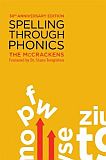You are here: Teaching Helps > General Education > Teach Reading and Writing
Spelling Through Phonics
By Diane Lilleberg

Spelling Through Phonics
Marlene and Robert McCracken
Portage & Main Pr, 2012
ISBN 1553793218, $25,
Available on ![]() Amazon
Amazon
Spelling Through Phonics is a multilevel phonics and spelling strategy that allows for the inclusion of phonics without it being the sole component of learning to read. The structured program focuses on making children writers as well as readers. While it is often difficult for young readers to apply their phonetic reading skills to writing, they can quite easily use any phonics/spelling skills developed through writing to their reading.
This strategy includes short daily assignments. The suggested activities can provide a great way to transition from one activity to another. The book is for primary grades (K–3), although the expectations for five and six-year-olds will not be challenging for many of our literacy-rich families. Other levels using a different approach can benefit from the process and patterns.
In addition to the book, a student chalkboard or whiteboard is recommended. Families can use the backside of scrap paper as a substitute. Daily spelling assignments are in four- to six-word groups. There are multiple sets and an excellent review system. It works very well with phonics workbooks such as ![]() Explode the Code.
Explode the Code.
Spelling Through Phonics works with any reading program, with suggestions for spelling through third grade, allowing students to advance at different rates. Directions are very simple and clear. While not agreeing with every suggestion, this approach was clearly developed from extensive and successful language-arts teaching experience with young students, not only for spelling or phonics, but for teaching children to write fluently.
The writing strategy suggested is both sound and simple and does not require special materials. The suggested writing strategy of this Canadian resource is for bound books, which can be helpful—they show the ongoing progress of children through the year. Three writing assignments are suggested each day: directed writing (according to a structure), handwriting, and free writing. The printing suggested is not a precursive alphabet but is not significantly different in formation other than slant and preconnection loops.
Permission is granted to copy, but not for commercial use.
